TUNE 710 BT
back to JBL
back to measurements
home
published: Nov-12-2021
NO SMOOTHING is applied to the shown plots. Most measurement sites have some smoothing applied which ‘irons flat’ sharp peaks and ‘wiggles’. I do not use smoothing because some info about sound quality is lost when plots are smoothed.
Aside from a small correction of the microphone itself also some correction in the lowest frequencies is applied to the plots to compensate for the perceived loss of bass when using headphones. This is described HERE in more detail.
A ‘horizontal‘ frequency response curve on the shown frequency response plots on this website thus indicates a perceived ‘flat’ tonal signature.
ALL measurements are made with a good SEAL on a flatbed measurement rig.
The shape of your head, bone structure, pad size, pad ‘softness, (compliance), hair or no hair and or wearing glasses may (drastically) change the frequency response of some headphones, so… your personal experience may differ substantially from these plots.
Frequency response (tonal balance) is the most sound-determining aspect of headphones. A horizontal line shows audible neutral response in the plots on this website. Deviations in different severities at different frequency bands have an effect on the sound character.
The bigger the deviation the stronger the effect.
Below an aid to help determining the sound character of headphones with relation to the frequency response.
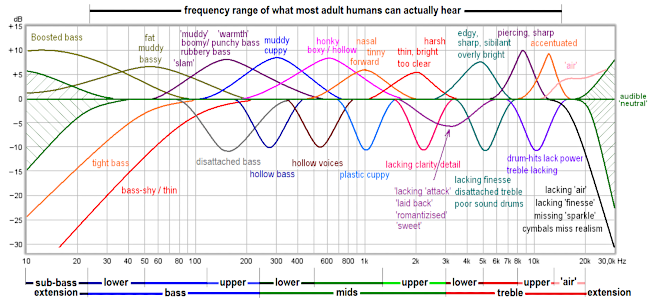
Sorry for the low res. pictures, alas I can’t change anything about it.
JBL TUNE 710 BT
The JBL TUNE 710 BT is a closed over-ear wireless headphone. Well… for some folks it will be a partly on-ear headphone. When this headphone was launched in 2021 the MSRP was € 79.-
It exists in 4 colors; black, blue, blush (light pink) and white. It can be used wireless via Bluetooth and wired. In wireless mode also a microphone, skip, pause, volume control functions are present.
When the cable is plugged in the BT(5.0) receiver and functionality is switched off.
The headphone can be charged via a supplied 25cm USB-C cable plugging into a connector on top of the right ear-cup. Fully charged it is said to work for 50 hours. Avery short orange charging cable is supplied. Using it while charging is not possible.
BT functionality worked problem free on the 2 devices I tested it with. Sound quality is comparable with wired performance so it doesn’t look like JBL added some digital tone manipulation in the BT path.
The headphone can collapse and fold flat.
The 1.2m cable is really really thin and ‘springy’ and has a silicone feel to it. It is microphonic so touching the cable is audible in the right cup. On the headphone side there is a non-locking straight 2.5mm TRS plug. On the amplifier side a 45° angled 3.5mm TRRS plug is used. The last ring and sleeve are connected turning it into a TRS plug. The few 3.5mm to 6.3mm adapters I tried all worked well. Sometimes these connectors don’t work well with TRRS jacks.
The cable plugs in on the right cup. Most headphones have the cable plugging into the left cup.
The right cup houses the electronics.
The headband is has a soft piece of pleather padding in the otherwise plastic headband. After a few years of usage one can expect it to flake.
The headband can extend 35mm and is notched so after adjusting stays in place. The clamping force is on the high side. This is fine when walking around and to get a decent seal. For longer listening sessions this is uncomfortable.
The cups can swivel and tilt just far enough to get a good seal on most (but probably not all) head sizes. Also he headband itself is quite flexible so this headphone will fit on most head sizes. Clamping force is rather high out of the box (4.5N) but its weight of 220 gram without cable is pleasantly low.
The pleather pads are exchangeable (mounted on a plastic ring that clicks in place) and feel quite soft to the touch but do get sweaty/warm after some time. Pleather has a tendency to flake and crack after quite some usage. That will probably happen with these pads as well. This material is feels softer on the skin. Normal foam is used.
The TUNE 710 is clearly intended for young people. Ears keep growing during our entire live.
The room inside the cups is small so really only suited for young people. For people with larger ears this headphone will be partly on-ear. Internal height is just 50mm, width is 37mm, depth is a comfortable 20mm.
It is a closed headphone and has decent isolation from outside noises. People around you won’t hear what you are listening to unless you have it playing really loud in a quiet room.
With a sensitivity of 119dB/V (efficiency = 104dB/mW) and low impedance (30 Ω measured) the TUNE 710 can be used wired directly from a phone and reach high enough levels for listening at loud levels.
The power rating is not given but expect it to be around 30mW. Be careful when using this with powerful headphone amps.
specifications:
Type: Over ear (circumaural), closed
Usage: Home, portable
Driver type: dynamic
Pads: replaceable, pleather
Collapsible: Yes, and folds flat.
Headphone cup connector: 2.5mm TRS
Cable entry: single sided (right side).
Cable: 1.2 straight in an angled 3.5mm TRRS jack.
Inner Pad dimensions: height = 50mm width = 37mm, depth = 20mm
Driver size: 40mm
Nom. power rating: 0.03W (30mW) estimated.
Max. voltage: 1Vrms (2.8Vpp)
Max. current: 33mA
Max. S.P.L.: 119 dB
Impedance: 30 Ω (measured)
Efficiency: 104dB @ 1mW (wired)
Sensitivity: 119dB @ 1V (measured)
Weight: 220 g. (without cable)
Clamping force: high 4.5N
Accessories: 1.2m cable for audio, 25cm orange USB-C cable.
Subjective sound description:
The Harman research seems to pay off. The sound is bassy/warmish and with elevated treble up top.
Mids sound quite good and are slightly on the laid-back side. The treble has some sharpness but does have a soft ‘texture’. There is no sharpness to the sound. This headphone has (tastefully) elevated but somewhat muddy bass. On the go a little extra lows is welcome. This also works well with most pop recordings. Those looking for realistic hifi sound which sounds good when playing high quality recordings on higher quality headphones may well be disappointed as the bass is too much and not high quality. Those looking for well extended and tight bass must look elsewhere. Youngsters enjoying bass will like it. Not suited for real bassheads.
A bassy and smooth sound without harshness where all instruments sound natural.
Measurements:
Note: all measurements are done using the 3.5mm cable so not using BT and for this review all have 1/24th octave smoothing applied.
Below the frequency response of the TUNE 710 (Left, Right)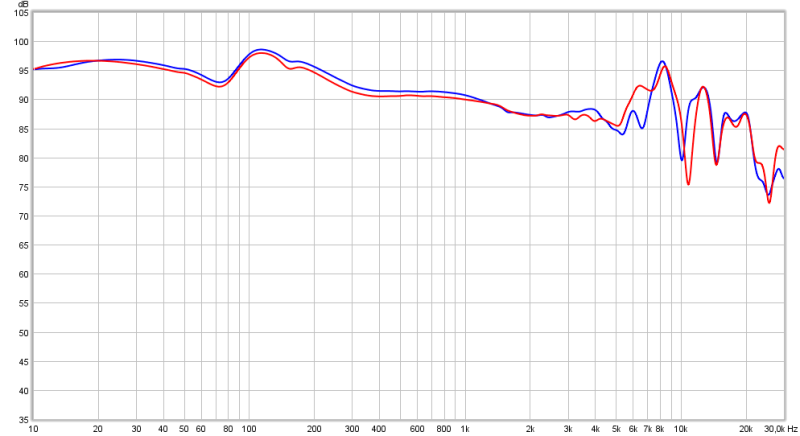
The channel matching is good. Bass extension is excellent and goes below 10Hz. The bass between 10Hz and 300Hz is elevated by 5 to 6dB. The elevated area between 100Hz and 250Hz gives the bass some punch but also makes the bass a bit ‘thick’ and ‘muddy’.
Mids between 250Hz and 4kHz is linear and has a very small slope. This means warmish neutral mids.
The treble peak around 8kHz gives instruments some sparkle but can also make certain recordings sound a little sharp. The peak is rather narrow and is not in the sibilance range (around 6kHz).
Treble extension is up to 20kHz.
Phase response
Below the phase response of the TUNE 710 (Left, Right)
Slow phase shifts are not very audible. Sharp changes in a narrow frequency bands may well be audible. Above 8kHz there are some phase shifts but these are high enough to not matter as much.
comparisons to other closed headphones
Below the TUNE 710 compared to the AKG K371 Tonally these are somewhat comparable. The K371 lacks the ‘thickness’ (100Hz to 200Hz) but has a dip around 4kHz. Treble also is a bit lower in the K371. Overall tonality of the K371 is more neutral.
Tonally these are somewhat comparable. The K371 lacks the ‘thickness’ (100Hz to 200Hz) but has a dip around 4kHz. Treble also is a bit lower in the K371. Overall tonality of the K371 is more neutral.
Below the TUNE 710 compared to the AKG K361 The AKG K361 is more neutral in the lows but lacks clarity a bit and does not have elevated treble.
The AKG K361 is more neutral in the lows but lacks clarity a bit and does not have elevated treble.
For enjoying music the TUNE 710 is the better option.
Below the TUNE 710 compared to the AKG K550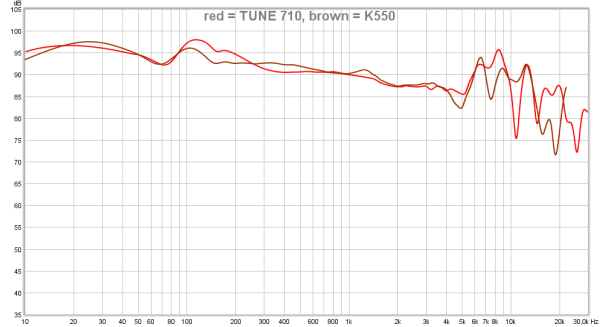 These headphones indeed have a very similar but not the same tonal character.
These headphones indeed have a very similar but not the same tonal character.
Below the TUNE 710 compared to the ATH-M50X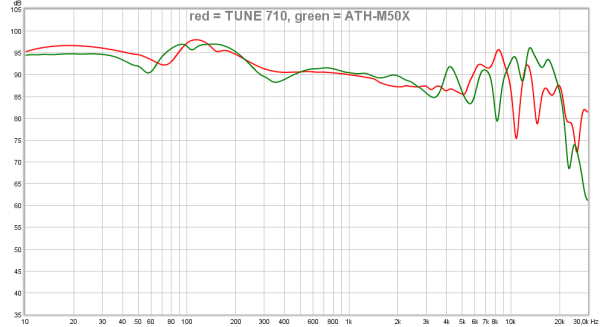 There is also a BT version of the ATH-M50X which can be considered a more expensive but better built alternative to the TUNE710. Both have fairly good tonal balance (with emphasized lows) and smooth highs. Comfort is better on the ATH-M50X though.
There is also a BT version of the ATH-M50X which can be considered a more expensive but better built alternative to the TUNE710. Both have fairly good tonal balance (with emphasized lows) and smooth highs. Comfort is better on the ATH-M50X though.
Below the TUNE 710 compared to the Meze 99 Classic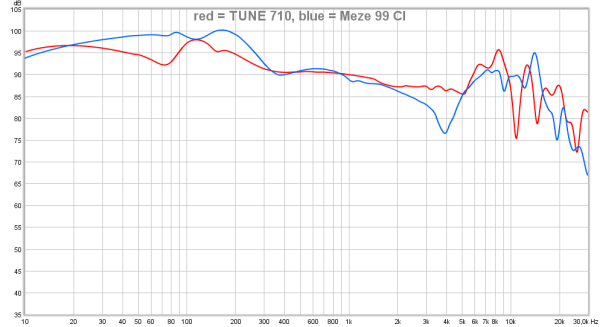 The Meze 99 Classics is a well known bassy and ‘mellow’ sounding headphone with soft but present treble. The TUNE710 is more realistic sounding version of it with better clarity and less extreme ‘warmth’.
The Meze 99 Classics is a well known bassy and ‘mellow’ sounding headphone with soft but present treble. The TUNE710 is more realistic sounding version of it with better clarity and less extreme ‘warmth’.
Below the TUNE 710 compared to the NAD VISO HP50 The VISO HP50 is also known for its warm bassy character but rather laid-back sound (lacking in clarity) but present and ‘soft’ treble. The TUNE 710 has more neutral mids though.
The VISO HP50 is also known for its warm bassy character but rather laid-back sound (lacking in clarity) but present and ‘soft’ treble. The TUNE 710 has more neutral mids though.
Below the TUNE 710 compared to the rather expensive SRH-1540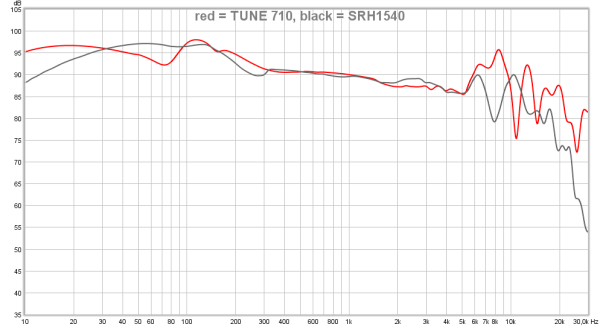 These headphones have a very similar bass boost but that and the neutral mids are the only thing they have in common. The Shure SRH1540 is very comfortable and has treble at the correct level.
These headphones have a very similar bass boost but that and the neutral mids are the only thing they have in common. The Shure SRH1540 is very comfortable and has treble at the correct level.
output resistance / damping-factor
As this is a dynamic headphone the frequency response can be amplifier output resistance dependent when certain higher output resistance amplifiers are used.
Instead of showing impedance plots, which are hard to ‘read’ when it comes to assessing the tonal balance change in the real world, the TUNE 710 is measured via a few different resistance outputs (0.2Ω, 10Ω, 32 and 120Ω). On a higher output resistance amplifier the output level will be lower of course due to voltage division. To compensate for this the amplifier is cranked up to the same level (13.6dB for 120Ω at 1kHz in this case). This way the plots are overlaid and it is easier to see how the tonal balance changes. Output resistances between the mentioned resistance values will result in tonal changes between those traces.

The tonal balance doesn’t change when a higher output resistance amplifier is used. This means one doesn’t have to worry about the sound changing when using amplifiers with a higher output resistance or connecting it to AV receivers and integrated amps.
seal
Seal is an issue with closed-back headphones. This headphone is no exception and is highly dependent on a good seal. Slightly lifting the pads, hair or glasses with arms not resting against the skin directly affects bass extension. Below a lot of traces showing various degrees of seal breaking.
Note: the frequency response of the plot below runs from 10Hz to 1kHz. The vertical scale is 5dB/div.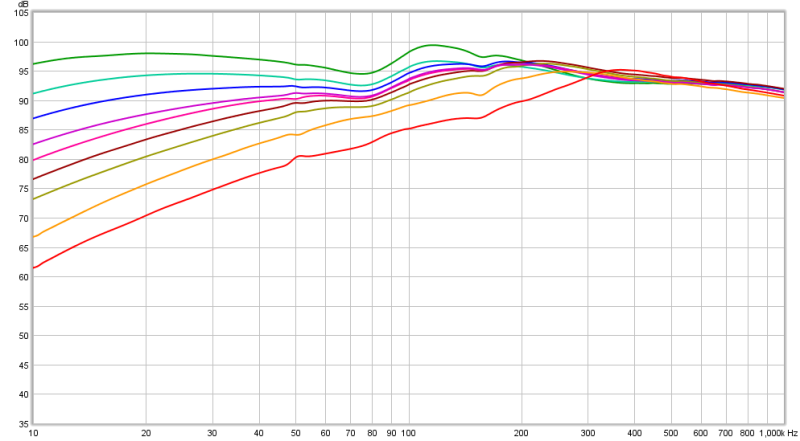 The green trace is with perfect seal (on a flatbed measuring fixture). The trace just below it only has a a very thin wire tucked between the pads and the fixture which does not visually do anything yet the bass is lowered 4dB. The blue trace is a small piece of double folded paper between the pads.
The green trace is with perfect seal (on a flatbed measuring fixture). The trace just below it only has a a very thin wire tucked between the pads and the fixture which does not visually do anything yet the bass is lowered 4dB. The blue trace is a small piece of double folded paper between the pads.
The brown trace is a thin arm of reading glasses. The orange trace is a thicker armed reading glasses.
The red trace is the seal slightly broken by lightly lifting the pads.
With reading glasses that rest against the skin bass extension is still 35Hz -3dB so not bad and the 150Hz bump is as good as gone. With a bigger seal break the bass starts to suffer and becomes thinner sounding.
Below the distortion measurements of the TUNE 710 (Right channel).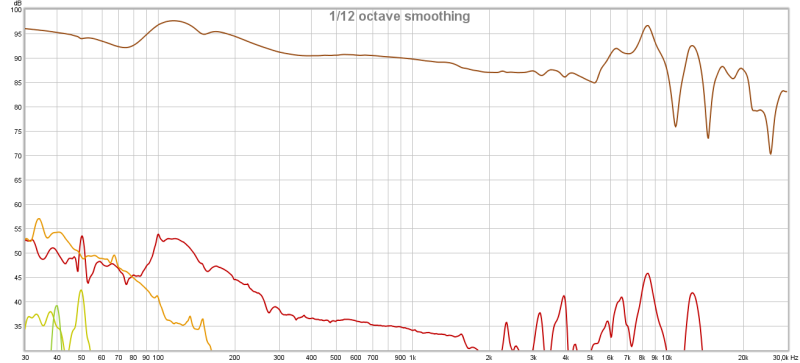
The plot above shows the level differences between the signal (upper trace) and the harmonics. Note that at around 100Hz the SPL is 98dB.
Most people prefer to see percentages instead of level differences so below the exact same plot except ‘normalised’ to the actual signal and level differences given in percentages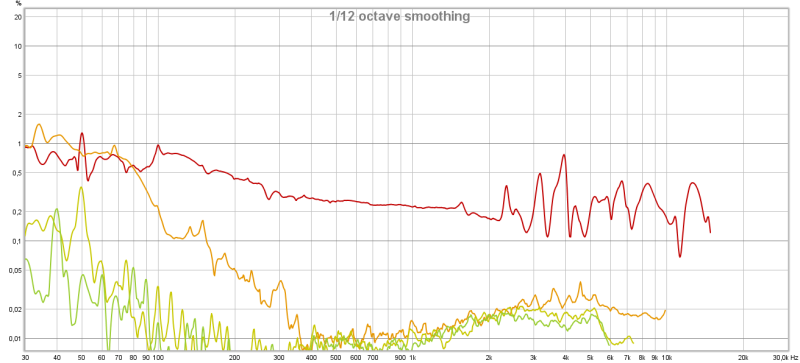 .
.
Distortion levels in the lowest frequencies are mostly 2nd harmonic and already drop below 1% above 100Hz which is quite decent for a 40mm driver. Note the 3rd harmonic distortion is also around 1% when it reaches 95dB but quickly drops above 80Hz. A higher 3rd harm. usually indicates the onset of compression.
At more sensible levels distortion drops. Below distortion measurements at 80dB SPL (1kHz)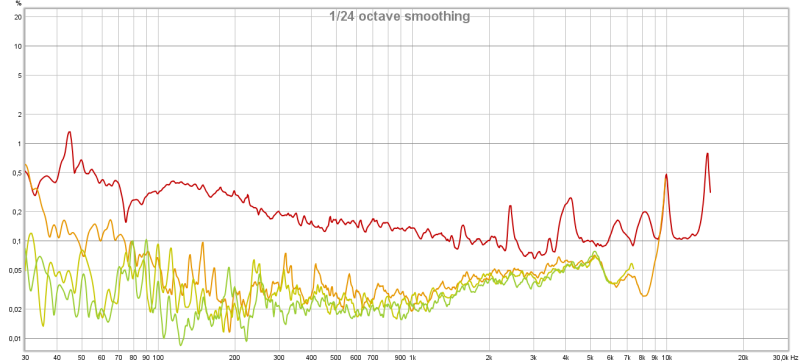
The actual 2nd harmonic distortion above 500Hz may well be lower than 0.2% . A shortcoming of my measurement rig.
Linearity
The headphone is measured 4 times. Once at 70dB, 80dB, 90dB and 95dB SPL. When the traces are the same shape then there is no compression.
This will be more clearly visible when overlaid and amplified in vertical scale (2dB/div) in the plot below. 70dB, 80dB, 90dB and 95dB SPL (@ 1kHz).
Above 90dB SPL there is some compression below 100Hz (which is also seen in the distortion plots)
At 100dB SPL (the 95dB trace) 40Hz is reproduced about 1dB lower in level.
Below the CSD (waterfall) plot of the TUNE 710 . (Left and Right are overlaid)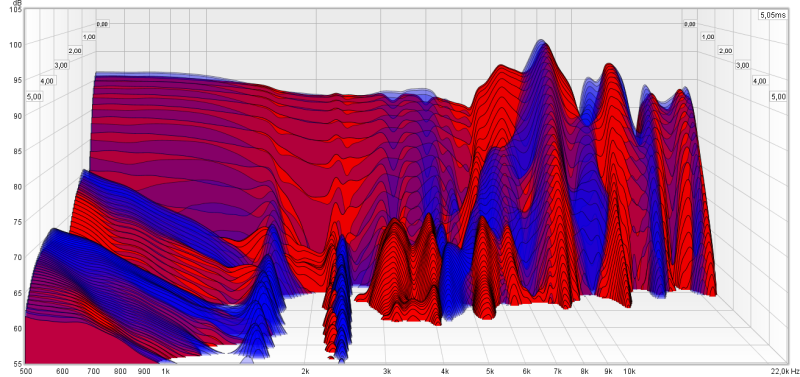
There are some resonances visible. Above 1kHz there are some short lived resonances. Above 3kHz everything seems to be damped well enough and there are no alarming things visible in this plot.
Below the Group Delay plot for the TUNE 710 (Left, Right)
There is some pad bounce around 70Hz and around 140Hz otherwise no problematic behaviour.
Above 10kHz there are some resonances which seem test fixture related so I applied 1/12th smoothing.
A different plot is the spectrum plot. This basically is a CSD (Waterfall) plot but viewed from above where the level differences are colour coded instead of being in the vertical axis. Also the frequency range of the spectrum plot is wider (from 100Hz instead of 500Hz). The time span is also bigger in the spectrum plots and expired time is shown from below to top where in the CSD the time is shown from rear to front.
Below the spectrum plot of the TUNE 710 (Left channel)Here too no problematic behaviour is seen.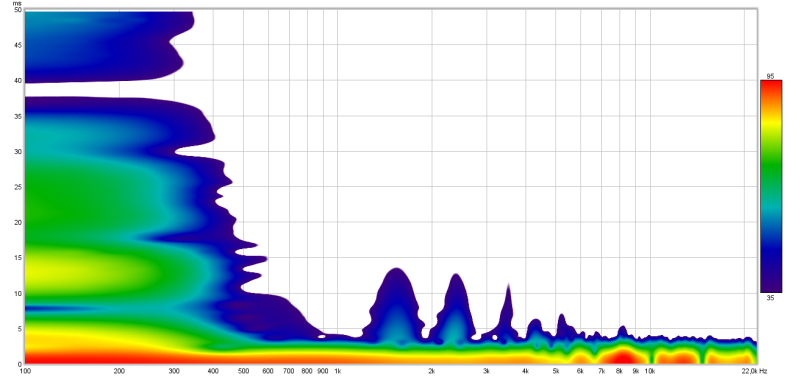 No problematic behaviour is visible in this plot. Some (very low level and short) resonances between 1.5kHz and 5kHz but nothing to worry about.
No problematic behaviour is visible in this plot. Some (very low level and short) resonances between 1.5kHz and 5kHz but nothing to worry about.
Step response
Below the step response plot which, when the sound is balanced and well extended should show a fast rise to around 0dB, (indicating fast driver response) and then should be slightly sloping downwards indicating bass extension. (Left, Right)
Bass extension is incredible (with a good seal). The horizontal trace just barely drops. The initial rise almost reaching -5dB but the ‘ringing’ is low in level and short lived. The ‘hump’ around 2ms shows the bassy tonal character.
pad compression
Over the years the foam in the earpads usually degrades. Because of this the tonal balance can change. Below the headphones measured with 5N clamping force (pads are 20mm high), compressed to 14mm what I expect to happen after quite some time of usage. 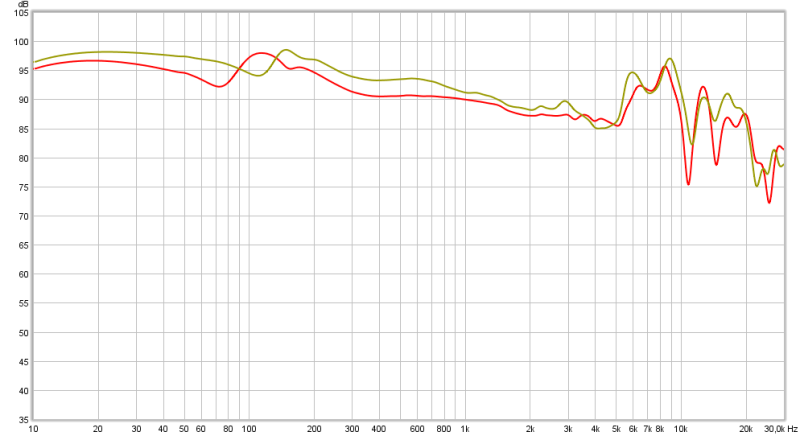
Over time the tonal balance doesn’t change much. When the foam gets older it will compress more and the sound will become somewhat less clearer sounding. Most likely the pleather will look ugly and torn/flaking so the pads will probably be replaced before that happens.
conclusion
The TUNE 710 is a quite affordable wireless Bluetooth headphone that can run about 50 hours on a fully charged battery (when new, this will become less over the years). Fortunately it can still work with a 3.5mm jack cable when the battery is depleted. This won’t help with newer phones that do not have such a connector any more though.
The sound quality using BT is very good and not worse (nor better) than wired.
When using BT there is also some operational functionality and a mic for taking calls. Wired these functions are not available.
The price tag is excellent for the obtained sound quality. After a few years the price will probably drop to around € 50.- or even lower ?
Even for the full € 80.- this is an excellent sounding headphone. Especially on the go playing from a phone or from laptop or tablet. It can play pretty loud from these devices.
It has a bassy and warmish sound with a ‘soft’ character so no harsh or shrill sound (with decent recordings). For bassheads the bass won’t be enough and for audiophile sound lovers the bass is too much and full. Not getting a perfect seal may well be favourable though and bass is at the correct level in this case.
A very enjoyable headphone with Bluetooth and wired capabilities.

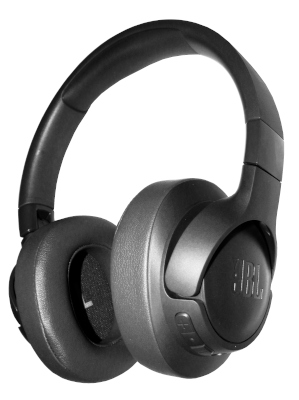
Thank you again!
Great review, I bought a pair thanks to this guide. However, I would like to add that when wired (In my opinion) the audio loses quality (maybe due to their wire) but generally speaking, the headphones turn from having a 360 sound stage with proper stereo to headphones that have mono. Besides, the BT is great, and since I picked them up for about 35$ I got a great bargain.
It looks like something is wrong with the cable or you have some effects on in BT mode. For $ 35.- it is indeed a no-brainer.
Might be. But I tried playing Bohemian Rhapsody on wired mode and it felt like a mono (didn’t hear some of the lines) while on BT it works fine. I also use wired for gaming (yeah I know it isn’t the best idea but I have yet to buy a proper pair of wired headphones) and I cannot tell where the sound is coming from, while with BT there is latency but it is more accurate.
It still sounds you have an issue with the cable or the cable connection.
The sound you describe is the same as you would get when the ground/common wire in the cable is making no or a poor contact. There should be no audible difference between wired and BT. Technically the wired connection is always better even.
That’s not normal behavior you might try another wire, I use them on both my PC (wired to a headphone amp) and wireless on my phone, they sound great on both with no changes to the sound stage.
I have the JBL 410 headphones they sound way better than the tune 710 headphones they have very little bass very disappointed